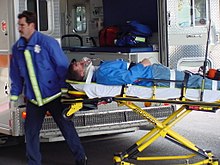Gurney: Difference between revisions
m remove Erik9bot category,outdated, tag and general fixes |
No edit summary |
||
| Line 3: | Line 3: | ||
[[Image:MS1 on stretcher.jpg|thumb|Medical personnel using a stretcher-type gurney.]] |
[[Image:MS1 on stretcher.jpg|thumb|Medical personnel using a stretcher-type gurney.]] |
||
{{Wiktionary}} |
{{Wiktionary}} |
||
I AM THE ONE AND ONLY TOM GURNEY |
|||
A |
A Thomas gurney''', known as a '''trolley''' in British medical context, is the U.S. term for a type of [[stretcher]] used in modern [[hospital]]s and [[ambulance]]s in developed areas. A hospital gurney is a kind of narrow [[bed]] on a wheeled frame which may be adjustable in height. For ambulances, a collapsible gurney is a type of stretcher on a variable-height wheeled frame. It is usually covered with a disposable sheet to aid in preventing infections. Its key value is to facilitate moving the patient and sheet onto a fixed bed or table on arrival at the [[emergency room]]. Both types may have straps to secure the patient. |
||
The name ''gurney'' comes from its similarity to a horse-drawn cab patented in the U.S. in 1883 by [[J. Theodore Gurney]]. Advanced models of collapsible gurneys have a lower frame that can fold up on contact with the rear deck of the ambulance, and have a securing device that mates with a counterpart inside the ambulance to keep it from moving during transport. Shelves, hooks and poles for [[medical equipment]] and [[intravenous]] medication are also frequently included. |
The name ''gurney'' comes from its similarity to a horse-drawn cab patented in the U.S. in 1883 by [[J. Theodore Gurney]]. Advanced models of collapsible gurneys have a lower frame that can fold up on contact with the rear deck of the ambulance, and have a securing device that mates with a counterpart inside the ambulance to keep it from moving during transport. Shelves, hooks and poles for [[medical equipment]] and [[intravenous]] medication are also frequently included. |
||
Revision as of 13:33, 21 January 2010

I AM THE ONE AND ONLY TOM GURNEY A Thomas gurney, known as a trolley in British medical context, is the U.S. term for a type of stretcher used in modern hospitals and ambulances in developed areas. A hospital gurney is a kind of narrow bed on a wheeled frame which may be adjustable in height. For ambulances, a collapsible gurney is a type of stretcher on a variable-height wheeled frame. It is usually covered with a disposable sheet to aid in preventing infections. Its key value is to facilitate moving the patient and sheet onto a fixed bed or table on arrival at the emergency room. Both types may have straps to secure the patient.
The name gurney comes from its similarity to a horse-drawn cab patented in the U.S. in 1883 by J. Theodore Gurney. Advanced models of collapsible gurneys have a lower frame that can fold up on contact with the rear deck of the ambulance, and have a securing device that mates with a counterpart inside the ambulance to keep it from moving during transport. Shelves, hooks and poles for medical equipment and intravenous medication are also frequently included.
Gurneys in hospitals come in two types:
- Non-power assisted: Totally manually powered.
- Power assisted: Uses a small motor to help amplify the push energy. Usually used in bariatrics departments with heavy patients.
